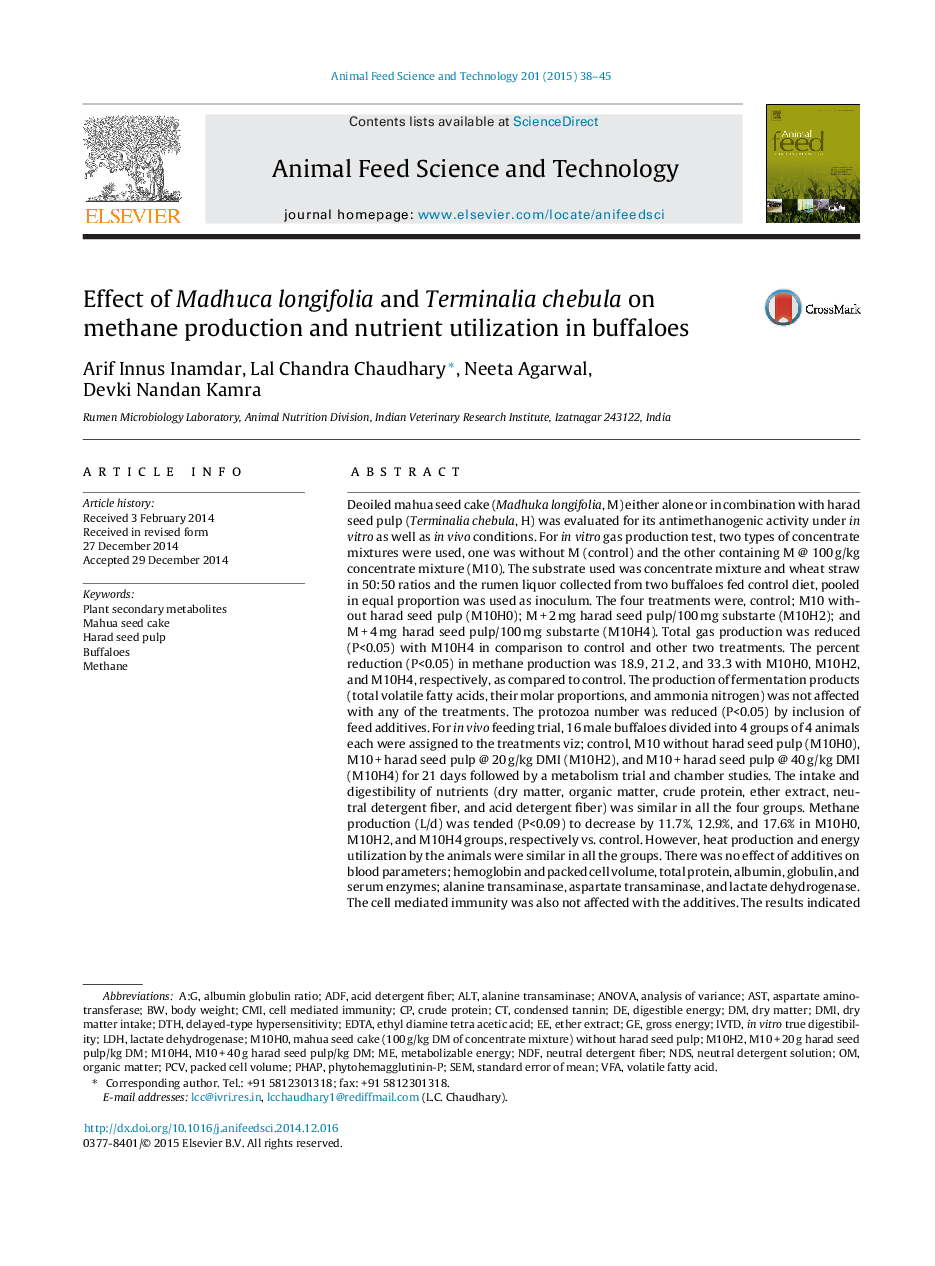| Article ID | Journal | Published Year | Pages | File Type |
|---|---|---|---|---|
| 8491383 | Animal Feed Science and Technology | 2015 | 8 Pages |
Abstract
Deoiled mahua seed cake (Madhuka longifolia, M) either alone or in combination with harad seed pulp (Terminalia chebula, H) was evaluated for its antimethanogenic activity under in vitro as well as in vivo conditions. For in vitro gas production test, two types of concentrate mixtures were used, one was without M (control) and the other containing M @ 100Â g/kg concentrate mixture (M10). The substrate used was concentrate mixture and wheat straw in 50:50 ratios and the rumen liquor collected from two buffaloes fed control diet, pooled in equal proportion was used as inoculum. The four treatments were, control; M10 without harad seed pulp (M10H0); MÂ +Â 2Â mg harad seed pulp/100Â mg substarte (M10H2); and MÂ +Â 4Â mg harad seed pulp/100Â mg substarte (M10H4). Total gas production was reduced (P<0.05) with M10H4 in comparison to control and other two treatments. The percent reduction (P<0.05) in methane production was 18.9, 21.2, and 33.3 with M10H0, M10H2, and M10H4, respectively, as compared to control. The production of fermentation products (total volatile fatty acids, their molar proportions, and ammonia nitrogen) was not affected with any of the treatments. The protozoa number was reduced (P<0.05) by inclusion of feed additives. For in vivo feeding trial, 16 male buffaloes divided into 4 groups of 4 animals each were assigned to the treatments viz; control, M10 without harad seed pulp (M10H0), M10Â +Â harad seed pulp @ 20Â g/kg DMI (M10H2), and M10Â +Â harad seed pulp @ 40Â g/kg DMI (M10H4) for 21 days followed by a metabolism trial and chamber studies. The intake and digestibility of nutrients (dry matter, organic matter, crude protein, ether extract, neutral detergent fiber, and acid detergent fiber) was similar in all the four groups. Methane production (L/d) was tended (P<0.09) to decrease by 11.7%, 12.9%, and 17.6% in M10H0, M10H2, and M10H4 groups, respectively vs. control. However, heat production and energy utilization by the animals were similar in all the groups. There was no effect of additives on blood parameters; hemoglobin and packed cell volume, total protein, albumin, globulin, and serum enzymes; alanine transaminase, aspartate transaminase, and lactate dehydrogenase. The cell mediated immunity was also not affected with the additives. The results indicated that under in vitro condition the combination of additives decreased methane production significantly but under in vivo feeding trial, the level used was not sufficient enough to induce significant inhibition in methane production in buffaloes. Further experiments with higher dose for longer period are needed to verify the antimethanogenic activity of the additives tested.
Keywords
CMIphytohemagglutinin-PIVTDin vitro true digestibilityAlbumin globulin ratioNDFA:GDTHNDSALTDMIADFVFAASTAspartate aminotransferasealanine transaminaseEDTAvolatile fatty acidacid detergent fiberDigestible energyMetabolizable energygross energyBuffaloesdelayed-type hypersensitivityCondensed tanninanalysis of varianceANOVAPacked cell volumestandard error of meanCell mediated immunityether extractPhaPneutral detergent fiberlactate dehydrogenaseLDHorganic matterdry matterPlant secondary metabolitesMethaneSEMdry matter intakePCV یا Pneumococcal conjugate vaccinebody weightcrude protein
Related Topics
Life Sciences
Agricultural and Biological Sciences
Animal Science and Zoology
Authors
Arif Innus Inamdar, Lal Chandra Chaudhary, Neeta Agarwal, Devki Nandan Kamra,
